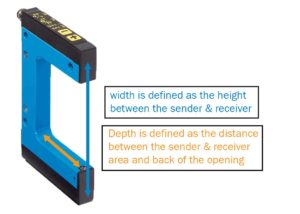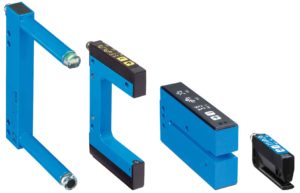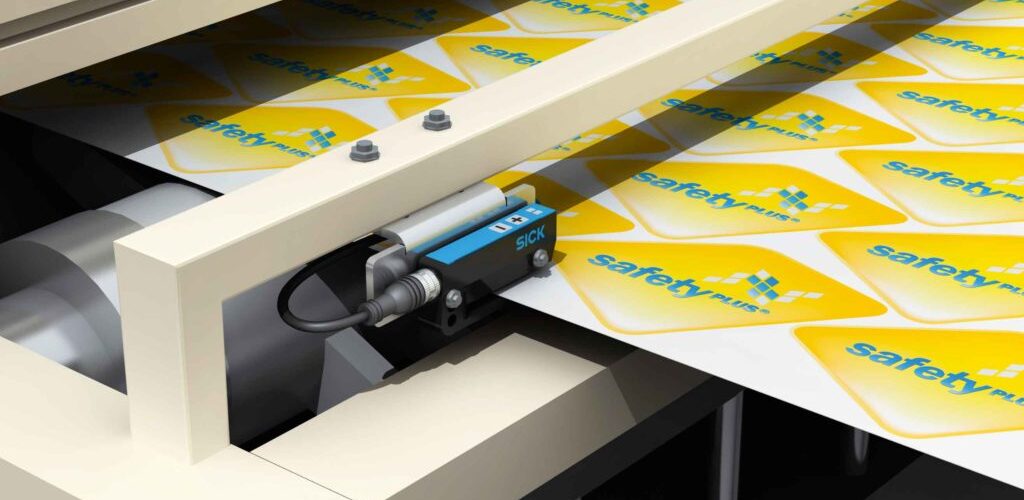In many industries, it is often vital to detect a product's color, registration marks, label presence and other important characteristics to ensure the final product meets specifications. A common solution is to use a registration sensor. Registration sensors are ideal for packaging applications, but can be used in a number of other industries, such as wood processing, print, paper, and general manufacturing. Applications range from positioning clear bottles and labels to color verification to detecting invisible marks on products.
Fork sensors are a type of registration sensor. The primary benefits of using fork sensors are easy installation, high immunity to ambient light, the ability to detect challenging materials, such as clear labels, and a wide variety of fork widths and depths available on the market.
Fork or slot sensors operate on a through-beam design; they combine the sender and receiver into a fixed housing so alignment is never an issue. They are typically used in labeling applications to detect the presence of the label compared to the carrier material. By adjusting the sensitivity (or teach-in function), even slight differences in the light attenuation are detected. There are many applications beyond the packaging industry for fork sensors that include conveyors, small parts detection, positioning of robot arm and general manufacturing.
How They Work – Optical vs. Ultrasonic
There are two types of fork sensor technologies available: optical (IR and laser) and ultrasonic. Most optical fork sensors use infrared (non-visible) light sources in simple applications and feature either manual adjustment to the sensitivity via potentiometer or teach-in through a button on the sensors face. Additional setup options also normally include changing the output state to light or dark operate dependent on the logic required. Many types also offer the potion of “locking” the sensor to prevent unauthorized personnel from changing the settings. Many fork sensor suppliers also offer Class I visible laser light sources that feature very small diameter spot sizes (<0.5 mm). This style of fork sensor is used where a small target needs to be detected or a precise position needs to be consistently detected.
changing the settings. Many fork sensor suppliers also offer Class I visible laser light sources that feature very small diameter spot sizes (<0.5 mm). This style of fork sensor is used where a small target needs to be detected or a precise position needs to be consistently detected.
Most fork sensors are used in simple applications in packaging to detect label positioning and the simple optical product is sufficient. But today's unique packaging designs that use clear packaging or clear labels on clear carrier materials demand unique solutions. Fork sensors that use ultrasonic technology solve all of these tough industry demands. Rather than optics (light), these fork sensors use ultrasonic (sound) but still maintain the characteristics of traditional optical fork sensors with fast respond switching frequencies. An additional unique solution that ultrasonic fork sensors can solve is to detect the presence/position of a film seam where, if present, the seam is thicker than the standard single film. Designs and operating procedures are the same as the standard optical products, thus giving consistency to maintenance procedures.
Unique Solutions for Unique Applications
One condition that progressive machine designers face today is the downsizing of the physical size of packaging equipment. Plant floor space is extremely tight regardless of the machine functio n. The smaller the component device, like sensors, the more effective use of floor space. The smallest optical fork sensors on the market are used for label detection and are only 60 mm long and 25 mm high with 2 mm width. Not sacrificing performance though with 50 microsecond response and easy teach-in though the HMI.
n. The smaller the component device, like sensors, the more effective use of floor space. The smallest optical fork sensors on the market are used for label detection and are only 60 mm long and 25 mm high with 2 mm width. Not sacrificing performance though with 50 microsecond response and easy teach-in though the HMI.
If your machine design calls for simplicity where no adjustments are required or wanted on the fork sensors, there are models with no manual adjustment or teach-in and out-of-the-box ease of installation. With a visible LED light source and output indicator, this family of sensors offers convenience, low cost and readability.
*****
Whether you are an OEM packaging machine builder who is constantly adding value to your machine design or the quality conscience end user, the fork sensors of yesterday are not the fork sensors of today. Unique solutions for fork sensor design are assuring quality consistent performance regardless of your application through varieties of models, functionality, and cost.
At Minneapolis-based SICK, Inc. different models are available. Mechanical alignment is assured due to a rugged IP 65 aluminum housing and a choice of wiring options is available with PNP or NPN circuitries. Quick changeover is achieved with a M8 connector on all units, thus ensuring the least amount of downtime.





